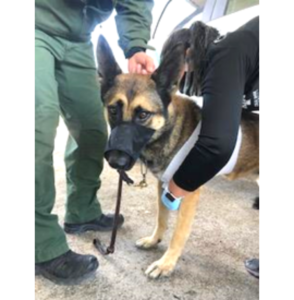CHAGAS
Portfolio: Risk Prevention & Risk Response
Project Title: CHAGAS
Status: Complete (2021)
 Overview: Through a continued effort supported by the DHS Office of Health Affairs (OHA) and led by researchers at Texas A&M University’s College of Veterinary Medicine and Biomedical Sciences, the epidemiology of Chagas disease in DHS working dogs continues to be investigated. DHS working dogs that spend time working outdoors in areas with established vector populations may be at heightened risk for infection, and therefore may provide a sensitive indication of regional risk of canine exposure. In addition to providing information useful for managing canine health, the team suggests that these dogs may serve as a sentinel for signaling emerging human health threats across the landscape, given that many of the pathogens are zoonotic and the dog handlers and other DHS personnel may be at risk. This research is providing DHS with new information on the emerging, vector-borne infections that are impacting the health and working ability of the canine task forces.
Overview: Through a continued effort supported by the DHS Office of Health Affairs (OHA) and led by researchers at Texas A&M University’s College of Veterinary Medicine and Biomedical Sciences, the epidemiology of Chagas disease in DHS working dogs continues to be investigated. DHS working dogs that spend time working outdoors in areas with established vector populations may be at heightened risk for infection, and therefore may provide a sensitive indication of regional risk of canine exposure. In addition to providing information useful for managing canine health, the team suggests that these dogs may serve as a sentinel for signaling emerging human health threats across the landscape, given that many of the pathogens are zoonotic and the dog handlers and other DHS personnel may be at risk. This research is providing DHS with new information on the emerging, vector-borne infections that are impacting the health and working ability of the canine task forces.
Project Duration: n/a
IIAD Project Team: Sarah Caffey
Outcomes, Solutions, & Impact: Through detailed clinical assessments of Chagas-infected dogs compared to uninfected dogs, the team is able to quantify the impact of the infection on canine health, and by continuing to collect data on dogs initially sampled in 2015, a long-term dataset is being built which is valuable given the chronic manifestations of Chagas disease. Additionally, the team is using an expansive archive of frozen canine blood samples to explore the prevalence of a suite of emerging vector-borne infections. The results of these investigations will allow DHS to understand, medically manage, and prevent these infections that not only impact dogs, but have the potential to infect humans as well. This is critical information for canine management and vector control programs, and a prerequisite for an effective disease management program.


